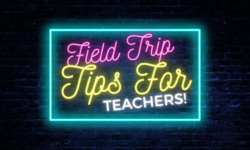Field trips are integral to young learning minds and especially so in the influential middle school years. Academic passions are discovered, sympathies are created, and what the students find in the real world helps to solidify who they will become in years to come. But that doesn't mean field trips have to be boring. Your students will thank you for a little entertainment, and in the end, they'll learn better if they're having fun. The following field trip ideas are geared toward middle school class groups in the United States, not limited to a single state, and are all around cool, awesome, and very educational.
Dinosaurs - First of all, what kid doesn't like dinosaurs? This love of prehistoric creatures oftentimes leads into adulthood, making it fun for the teacher and chaperones too. There are several sites, museums, digs, and monuments around the U.S. that are dedicated to educating the public on these long-dead animals. Some of the more popular sites include the La Brea Tar Pits in Los Angeles, which is focused primarily on the Pleistocene Era when woolly mammoths, saber-tooth cats, and dire wolves roamed the continent. Other sites date further back, before the last ice age, to the time when triceratops and tyrannosaurus-rex walked the earth like at the paleontological dig sites in the South Dakota Badlands. Companies like PaleoAdventures give dinosaur dig site tours to students ages 10 and up, showing the inner workings of an operational dig site and the scientific importance of recovering the fossils, bones, and fragments from the hard earth. These dig sites cross state lines into Montana and Wyoming as well though you can find similar tours in other states. If your group would be better suited to indoor exploration, try the Smithsonian affiliated museums like the National Museum of Natural History in Washington, D.C. which has a phenomenal dinosaur wing of the Field Museum in Chicago where you can see "Sue," the most complete T-Rex skeleton ever to be pulled from the ground.
Historic Sites - Though historic sites aren't as fun as dinosaurs, they are pretty cool. Living history museums like Colonial Williamsburg are usually very well received by young students and the park has an awesome feature where your group can stay overnight and learn even more after dark. Plimoth Plantation is another such destination on the East Coast and you can board and tour the full-scale replica of the Plimoth tall ship among their other attractions. If your middle school class isn't learning about early America, perhaps you'd like to visit Civil War sites instead. Dotting the country from east to west, north, and south, Civil War sites of significance are plentiful and poignant. Antietam, Gettysburg, Fort Sumter, and Shiloh are but a few of the most important battle sites in the country and while they are highly informative, they are also big crowd-pleasers. Middle school students pretty much unanimously love seeing cannons and Civil War-era weaponry, seeing demonstrations and reenactments, and the antique artifacts dating back to the War Between the States. If you're far enough south, historic plantations are another great place to visit. Sherwood Forest in Virginia was once owned by two presidents, William Henry Harrison and John Tyler, and is open to visitors. George Washington's Mount Vernon and Thomas Jefferson's Monticello are also open for visitors with living history presentations, in-depth tours, and offer a wonderfully comprehensive look into the presidents' lives.
Interactive Science Museums - It can be hard to find a good science museum for middle school students as many walks the line of elementary school level science. There are interactive science museums which focus specifically on breaking boundaries between grades and teach concepts like the Leonardo in Salt Lake City. This revolutionary new science museum actually spans the gamut of education, just like real Leonardo (DaVinci that is), and includes architecture, art, music, and more into a symposium of learning in a fun and inviting way. The Franklin in Philadelphia does the same under the inspiration of Benjamin Franklin. The Museum of Science and Industry in Chicago, the largest science museum in the Western Hemisphere, is perhaps one of the best destinations to take classes of any age. Likewise, on the West Coast, you'll find the Discovery Cube in Los Angeles which combines science with multi-sensory exploration to heighten learning.
Natural Disasters and Natural Wonders - This is kind of the same thing with the dinosaurs. Kids, especially middle school-aged students, enjoy seeing natural disasters from a safe distance. Volcanoes make for great learning opportunities (especially when they're dormant) so take them on a tour of Yellowstone National Park and see the effects of the geothermal features like Old Faithful and the sulfur pools. California has its own, underrated volcanic park at Lassen Peak in the Shasta Cascade region in the northern part of the state. Lassen Volcanic National Park also has its own geothermal wonderland, known as Bumpass Hell, where you can tour along boardwalks through the sulfurous landscape. For active volcanoes, go down to Hawaii and see the Hawaii Volcanoes National Park where you'll find two of the most active volcanoes on the planet still oozing hot lava before your eyes. From a natural wonder standpoint, you can pretty much visit any national park in the country. The Grand Canyon is, of course, recommended as is the Everglades in Florida, Waimea Canyon in Hawaii, and Devils Tower in Wyoming among many others.
Zoos and Aquariums - Last but not least: animals. Zoos and aquariums always rank among the best and coolest, most informative and educational field trip destinations in the country for all ages. You can literally make any subject work by visiting a zoo: biology, zoology, general science, psychology, architecture, civil engineering, history, marketing, etc. Plus, the students always look forward to a day at the zoo, touring their favorite animals. They probably don't even notice that they're learning, which is a great thing. The older your students get, the more in-depth and focused their visits to the zoo and aquarium can become. Zoos like the San Diego Zoo offer educational programs, tours, and activities for all ages of students with graduating levels of focus. Have your middle school students tour the park and listen to zookeepers talk about particular animals and their behaviors, their needs, and the zoo's conservation practices to help the species in the wild. Other zoo institutions that rank very highly include the Smithsonian's National Zoological Park and the Audubon Nature Institute in New Orleans which is also home to a fabulous aquarium. The Dallas World Aquarium, Monterey Bay Aquarium in California, and the National Aquarium in Baltimore are among the top ten in the nation as well, and likewise offer educational programs for groups.




